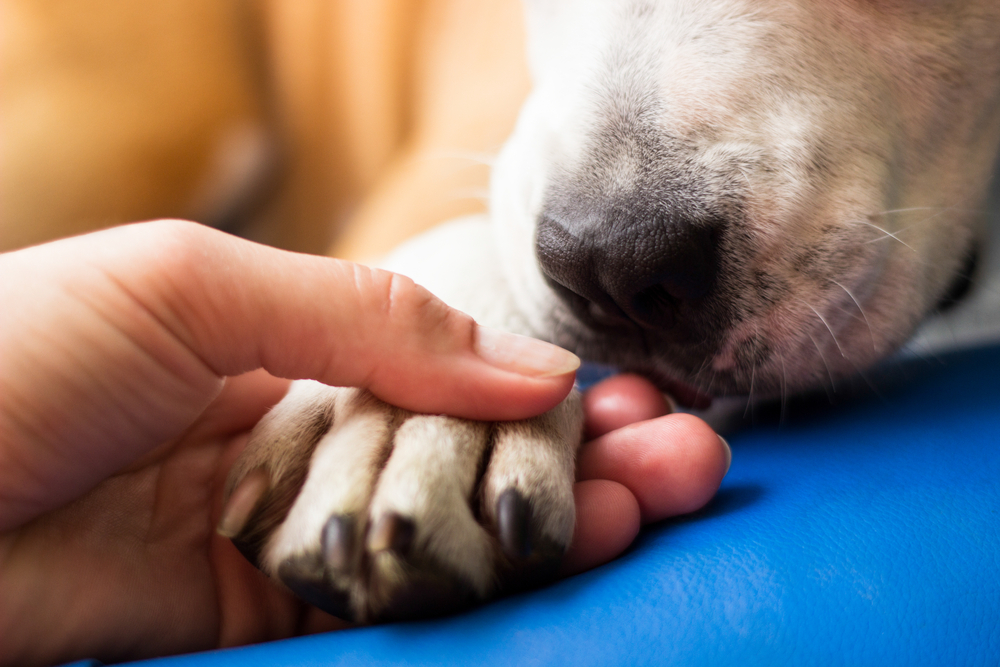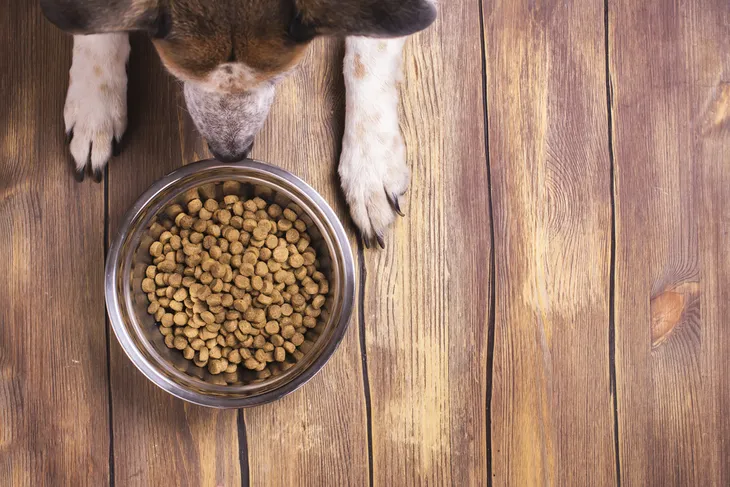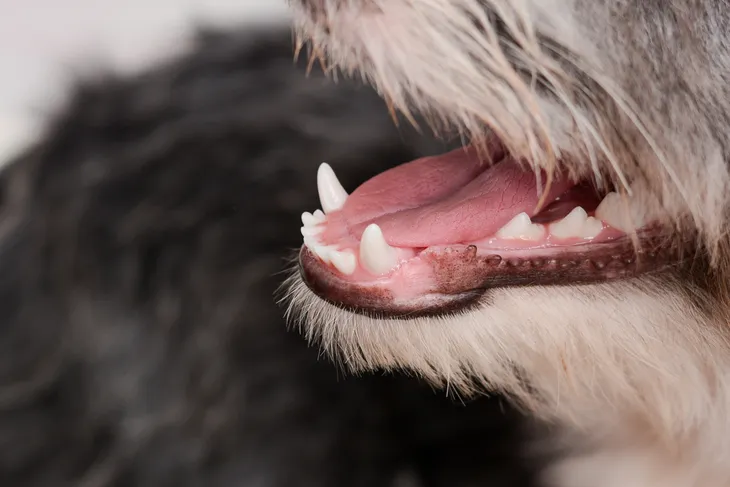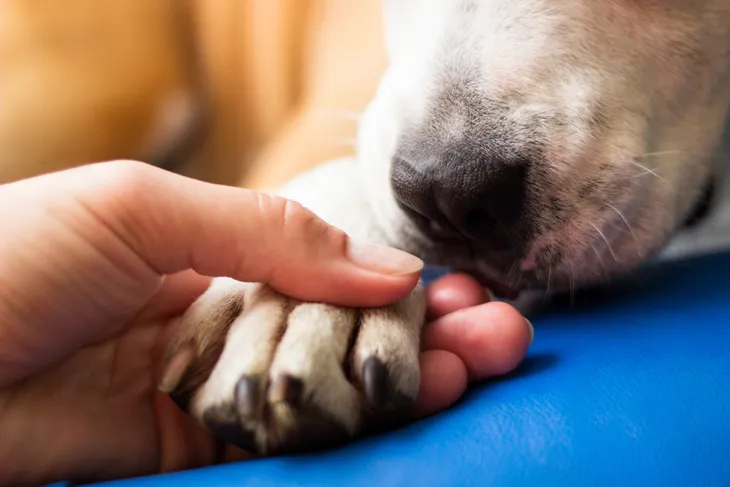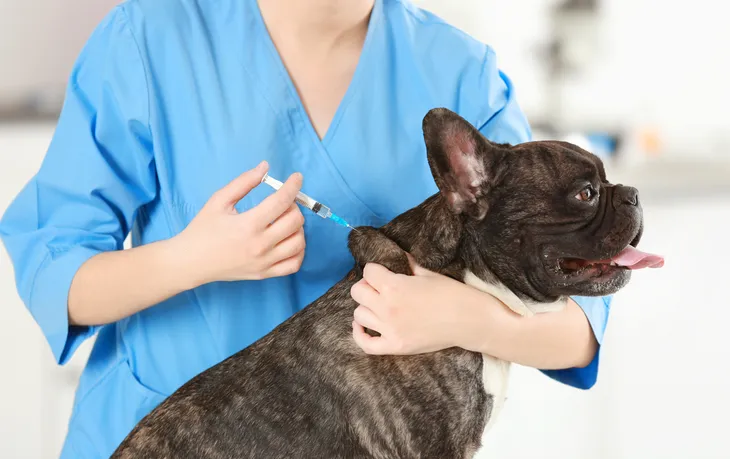Canine distemper is a viral illness that affects dogs. It is highly contagious, and can be spread among dogs and other animals including coyotes, ferrets, foxes, raccoons, and skunks, among others.
Distemper is caused by a virus that belongs to the same family as the viruses that result in human diseases like mumps and measles. Vaccines that protect against canine distemper do exist, and in many legal jurisdictions, they are required. However, since dogs are usually inoculated as puppies, they may be sold to new owners before all the necessary booster shots can be given. In such cases, the animal lacks adequate protection and will be at risk for catching distemper in the future.
Recognize the Symptoms of Canine Distemper
Distemper is considered a serious, potentially life-threatening condition, so contact your vet immediately if you notice any of these symptoms (note: treatment options are listed after the 7 symptoms below):
Symptom: Fever
One of the first clinical signs of canine distemper is a high fever (of more than 103.5 degrees Fahrenheit or 39.7 degrees Celsius). You will notice your dog is unusually warm to the touch, but it will also be obviously ill when you look at it, as the fever will be accompanied by red eyes and a runny, watery discharge coming from its eyes and nose.
Fever symptoms will usually appear three to six days after your dog is infected, once the virus takes root in your dog’s body. Increasingly severe symptoms will usually follow.
Symptom: Loss of energy
Dogs with distemper typically experience a sudden, dramatic loss of energy, or lethargy. They may also seem to be depressed, as they will lose interest in playing and other activities they typically enjoy.
This lethargy typically follows the onset of fever, and may be accompanied by prolonged periods of sleep or near-total inactivity. If your usually-energetic pet suddenly comes down with a fever and seems to lose all its energy, contact your vet immediately.
Symptom: Loss of appetite
Dogs with distemper also lose their interest in food. They may refuse to eat altogether, or they may simply eat much less than they normally would.
This loss of appetite tends to make the lack of energy and lethargy symptoms worse, as these two clinical signs have a reciprocal relationship. The less a dog eats, the less energy it has; the less energy it has, the more lethargic it becomes. Your dog may lose a noticeable amount of weight in a very short period of time.
Symptom: Sneezing
Some dogs with canine distemper are prone to sneezing, which can be very problematic if you have other pets in the house, as this is one of the main ways the virus is spread. In some cases, it may be necessary to quarantine your pet if you live in a multi-pet household and you’re not sure about the immunity status of the other animals in your home.
Distemper-related sneezing will usually be productive, meaning that it will result in the ejection of thick mucus. However, some pets simply develop a runny nose rather than sneezing symptoms.
Symptom: Coughing
Your dog is also likely to develop a constant, severe cough if it has canine distemper. This persistent coughing is a sign that the disease is spreading and that symptoms are worsening.
If you notice your pet has a constant cough, you should take it to the vet even if there are no other signs of distemper. The exact symptoms will vary from case to case, and coughing may be one of the only obvious outward signs of distemper infection that your pet develops.
Symptom: Vomiting and Diarrhea
As the virus continues to spread, your pet may start vomiting or develop diarrhea. These are signs of an acute medical emergency. Take your pet for immediate veterinary attention.
In severe cases, neurological symptoms develop alongside vomiting and diarrhea. Seizures, fits, partial paralysis, and sudden, dramatic episodes of hysteria can also occur in dogs with advanced cases of canine distemper. Many dogs who recover from the disease go on to develop one or more permanent symptoms related to these neurological abnormalities, such as involuntary twitches.
Symptom: Hardened Foot Pads
Canine distemper is sometimes referred to as “hard pad disease,” because certain forms of the virus are known to cause a distinctive hardening or enlargement of the soft pads on the bottoms of your dog’s paws. While this is one of distemper’s least severe symptoms, it is also one of the signature signs of the disease.
Keep in mind that taken individually, each of these symptoms could indicate the presence of a disease other than distemper, as they are fairly common indicators of a viral infection. However, it is rare for other conditions to cause three or more of these symptoms to occur in tandem.
Treatment Options for Canine Distemper
Unfortunately, there is no cure for canine distemper, and it can be fatal. Your dog’s chances of surviving depend on factors including its age, overall health, and the condition of its immune system.
Here are some treatment options:
Treatment Option: Prevention
The old adage that “prevention is the best treatment” certainly applies to canine distemper. Make sure your pet receives its primary distemper vaccination, and follows its complete course of supplementary booster shots to completion. Skipping any of the boosters will leave your pet unprotected, and if you’ve acquired a new dog and you’re not sure whether or not it’s had its shots, talk to your vet about the available options.
As a pet owner, you have a role to play in distemper prevention. Failure to complete a pet’s inoculation schedule is a major contributing factor to distemper outbreaks.
Treatment Option: Intravenous Fluids
As for actually treating the symptoms of distemper, your pet’s care team only has palliative options available. “Palliative” is a medical term that means the symptoms, and not their root cause, are being treated. The goal of palliative care is to improve your pet’s comfort and increase its chances of making a full recovery.
Intravenous fluids are a mainstay of palliative care for canine distemper. Dangerous levels of dehydration can quickly result from diarrhea and vomiting, and maintaining your pet’s fluid levels is an essential aspect of treatment.
Treatment Option: Antibiotics
Secondary infections can sometimes occur in dogs suffering from acute bouts of canine distemper, since their immune systems are compromised. Opportunistic bacteria may take hold, either externally or internally.
If this happens, or as a preventative measure, your vet may recommend that your dog take a course of broad-spectrum antibiotics. These drugs will ward off any secondary bacterial infections, allowing your dog’s immune system to concentrate on fighting off the distemper virus.
Treatment Option: Anti-Seizure Medications
Some dogs experience tremors or seizures as the virus that causes distemper runs its course. If this is the case, your pet’s care team will recommend the use of anti-seizure medications that are specially formulated to help prevent this troubling and traumatic symptom.
In some cases, a class of drugs known as anti-inflammatories may also be recommended. These drugs will help stabilize your pet’s condition and keep any internal swelling or inflammation under control.
Treatment Option: Nutrition and Nursing Care
Your dog may require hospitalization so it can receive specialized nutrition and nursing care aimed at controlling and relieving its coughing, diarrhea, and vomiting. It will be hard for you to leave your pet at this difficult time, but it’s for the best as your dog will benefit from round-the-clock attention and the close proximity of medical professionals.
It can be difficult to predict the prognosis for a dog with canine distemper, so ask your vet for a case-specific assessment.
